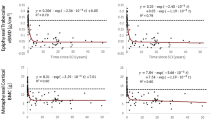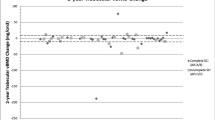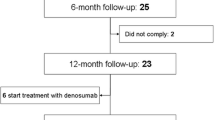Abstract
The prevalence of osteoporosis is high among postmenopausal women and individuals sustaining a spinal cord injury (SCI). We assessed the effects of estrogen loss and unloading on the trabecular bone of the knee in women. Pre- and postmenopausal ambulatory women (n=17) were compared to pre- and postmenopausal women with SCI (n=20). High-resolution magnetic resonance imaging was used to compare groups on apparent measures of trabecular bone volume, trabecular number, trabecular spacing, and trabecular thickness in the distal femur and proximal tibia, regions with a high proportion of trabecular bone and the most common fracture site for SCI patients. Trabecular bone was deteriorated in women with SCI compared to ambulatory women. SCI groups had fewer, (−19 and −26% less) and thinner trabeculae (−6%) that were spaced further apart (40% and 62% more space between structures) resulting in less trabecular bone volume (−22% and −33%) compared to the ambulatory groups (tibia and femur, respectively). Postmenopausal women with SCI also had 34% greater trabecular spacing in the tibia compared to the 40-year-old premenopausal women with SCI, showing an interaction between unloading and estrogen loss. Middle-aged postmenopausal, ambulatory women, not taking estrogen or medications that affect bone, did not show the deteriorated trabeculae that were evident in women with SCI, nor did they show differences in distal femur and proximal tibia trabeculae compared to a premenopausal group. We conclude that the effect of unloading on bone architecture is greater than that of estrogen loss in middle-aged women.




Similar content being viewed by others
References
WHO (1994) Assessment of fracture risk and its application to screening for postmenopausal osteoporosis. Report of a WHO Study Group. World Health Organ Tech Rep Ser, 843
Biering-Sorensen F, Bohr HH, Schaadt OP (1990) Longitudinal study of bone mineral content in the lumbar spine, the forearm and the lower extremities after spinal cord injury. Eur J Clin Invest 20:330
Minaire P, Neunier P, Edouard C, Bernard J, Courpron P, Bourret J (1974) Quantitative histological data on disuse osteoporosis: comparison with biological data. Calcif Tissue Res 17:57
Bagi CM, Miller SC (1994) Comparison of osteopenic changes in cancellous bone induced by ovariectomy and/or immobilization in adult rats. Comparison of osteopenic changes in cancellous bone induced by ovariectomy and/or immobilization in adult rats. Anat Rec 239:243–254
Cavolina JM, Evans GL, Harris SA, Zhang M, Westerlind KC, Turner RT (1997) The effects of orbital spaceflight on bone histomorphometry and messenger ribonucleic acid levels for bone matrix proteins and skeletal signaling peptides in ovariectomized growing rats. The effects of orbital spaceflight on bone histomorphometry and messenger ribonucleic acid levels for bone matrix proteins and skeletal signaling peptides in ovariectomized growing rats. Endocrinology 138:1567–1576
Ito M, Nishida A, Nakamura T, Uetani M, Hayashi K (2002) Differences of three-dimensional trabecular microstructure in osteopenic rat models caused by ovariectomy and neurectomy. Bone 30:594
Li XJ, Jee WS, Chow SY, Woodbury DM (1990) Adaptation of cancellous bone to aging and immobilization in the rat: a single photon absorptiometry and histomorphometry study. Anat Rec 227:12
Westerlind KC, Wronski TJ, Ritman EL et al. (1997) Estrogen regulates the rate of bone turnover but bone balance in ovariectomized rats is modulated by prevailing mechanical strain. Estrogen regulates the rate of bone turnover but bone balance in ovariectomized rats is modulated by prevailing mechanical strain. Proc Natl Acad Sci USA 94:4199–4204
Consensus development conference (1991) Diagnosis, prophylaxis and treatment of osteoporosis. Am J Med 90:107
Bell GH, Dunbar O, Beck JS, Gibb A (1967) Variations in strength of vertebrae with age and their relation to osteoporosis. Calcif Tissue Res 1:75
Dempster DW, Shane E, Horbert W, Lindsay R (1986) A simple method for correlative light and scanning electron microscopy of human iliac crest bone biopsies: qualitative observations in normal and osteoporotic subjects. J Bone Miner Res 1:15
Mann T, Oviatt SK, Wilson D, Nelson D, Orwoll ES (1992) Vertebral deformity in men. J Bone Miner Res 7:1259
Parfitt AM (1987) Trabecular bone architecture in the pathogenesis and prevention of fracture. Am J Med 82:68
Looker AC, Johnston CC Jr, Wahner HW, et al. (1995) Prevalence of low femoral bone density in older U.S. women from NHANES III. J Bone Miner Res 10:796
Melton LJ, 3rd, Chrischilles EA, Cooper C, Lane AW, Riggs BL (1992) Perspective. How many women have osteoporosis? J Bone Miner Res 7:1005
Claus-Walker J, Halstead LS (1982) Metabolic and endocrine changes in spinal cord injury: IV. Compounded neurologic dysfunctions. Metabolic and endocrine changes in spinal cord injury: IV. Compounded neurologic dysfunctions 63:632
Lazo MG, Shirazi P, Sam M, Giobbie-Hurder A, Blacconiere MJ, Muppidi M (2001) Osteoporosis and risk of fracture in men with spinal cord injury. Spinal Cord 39:208
Vestergaard P, Krogh K, Rejnmark L, Mosekilde L (1998) Fracture rates and risk factors for fractures in patients with spinal cord injury. Spinal Cord 36:790
Krause JS (2000) Aging after spinal cord injury: an exploratory study. Spinal Cord 38:77
Frisbie JH (1997) Fractures after myelopathy: the risk quantified. J Spinal Cord Med 20:66
Modlesky CM, Majumdar S, Narisimhan A, Dudley GA (2004) Trabecular bone microarchitecture is deteriorated in men with spinal cord injury. J Bone Miner Res 19:48–55
Roberts D, Lee W, Cuneo RC et al. (1998) Longitudinal study of bone turnover after acute spinal cord injury. J Clin Endocrinol Metab 83:415
Harris S, Dawson-Hughes B, Usda Human Nutrition Research Center on Aging TUBMA (1992) Rates of change in bone mineral density of the spine, heel, femoral neck and radius in healthy postmenopausal women. Rates of change in bone mineral density of the spine, heel, femoral neck and radius in healthy postmenopausal women. Bone Miner 17:87–95
Mosekilde L (1990) Consequences of the remodelling process for vertebral trabecular bone structure: a scanning electron microscopy study (uncoupling of unloaded structures). Bone Miner 10:13
Ahlborg HG, Johnell O, Nilsson BE, Jeppsson S, Rannevik G, Karlsson MK (2001) Bone loss in relation to menopause: a prospective study during 16 years. Bone 28:327
Falch JA, Sandvik L (1990) Perimenopausal appendicular bone loss: a 10-year prospective study. Bone 11:425
Ravn P, Hetland ML, Overgaard K, Christiansen C (1994) Premenopausal and postmenopausal changes in bone mineral density of the proximal femur measured by dual-energy X-ray absorptiometry. J Bone Miner Res 9:1975
Ouyang X, Selby K, Lang P et al. (1997) High resolution magnetic resonance imaging of the calcaneus: age-related changes in trabecular structure and comparison with dual X-ray absorptiometry measurements. High resolution magnetic resonance imaging of the calcaneus: age-related changes in trabecular structure and comparison with dual X-ray absorptiometry measurements. Calcif Tissue Int 60:139–147
WHO (1981) Research on the menopause. World Health Organ Tech Rep Ser, 670
Beuf O, Ghosh S, Newitt DC et al. (2002) Magnetic resonance imaging of normal and osteoarthritic trabecular bone structure in the human knee. Arthr Rheum 46:385
Majumdar S, Genant HK, Grampp S et al. (1997) Correlation of trabecular bone structure with age, bone mineral density, and osteoporotic status: in vivo studies in the distal radius using high resolution magnetic resonance imaging. J Bone Miner Res 12:111
Majumdar S, Newitt D, Mathur A et al. (1996) Magnetic resonance imaging of trabecular bone structure in the distal radius: relationship with X-ray tomographic microscopy and biomechanics. Osteoporos Int 6:376
Majumdar S, Link TM, Augat P et al. (1999) Trabecular bone architecture in the distal radius using magnetic resonance imaging in subjects with fractures of the proximal femur. Osteoporos Int 10:231
Ouyang X, Majumdar S, Link TM et al. (1998) Morphometric texture analysis of spinal trabecular bone structure assessed using orthogonal radiographic projections. Med Phys 25:2037
Newitt DC, van Rietbergen B, Majumdar S (2002) Processing and analysis of in vivo high-resolution MR images of trabecular bone for longitudinal studies: reproducibility of structural measures and micro-finite element analysis derived mechanical properties. Osteoporos Int 13:278
Modlesky CM, Bickel CS, Slade JM, Meyer RA, Cureton KC, Dudley GA (2003) Assessment of skeletal muscle mass in men with spinal cord injury using dual-energy X-ray absorptiometry and magnetic resonance imaging. J Appl Physiol epub:
Hefferan TE, Evans GL, Lotinun S, Zhang M, Morey-Holton E, Turner RT (2003) Effect of gender on bone turnover in adult rats during simulated weightlessness. J Appl Physiol 95:1775
Lindsay R (1988) Sex steriods in the pathogenesis and prevention of osteoporosis. In: Riggs BL (ed) Osteoporosis: etiology, diagnosis and management. Raven Press, New York, p 333
Dawson-Hughes B, Harris SS, Krall EA, Dallal GE, Falconer G, Green CL (1995) Rates of bone loss in postmenopausal women randomly assigned to one of two dosages of vitamin D. Am J Clin Nutr 61:1140
Lindsay R, Nieves J, Formica C et al. (1997) Randomised controlled study of effect of parathyroid hormone on vertebral-bone mass and fracture incidence among postmenopausal women on oestrogen with osteoporosis. Lancet 350:550
Patel R, Blake GM, Rymer J, Fogelman I (2000) Long-term precision of DXA scanning assessed over seven years in forty postmenopausal women. Osteoporos Int 11:68
Christiansen C, Riis BJ, Rodbro P (1987) Prediction of rapid bone loss in postmenopausal women. Lancet 1:1105
Garland DE, Adkins RH, Stewart CA, Ashford R, Vigil D (2001) Regional osteoporosis in women who have a complete spinal cord injury. J Bone Joint Surg [Am] 83-A:1195
Comarr AE, Hutchinson, RH, Bors E (1962) Extremity fractures of patients with spinal cord injuries. Am J Surg 103:732
Freehafer AA (1995) Limb fractures in patients with spinal cord injury. Arch Phys Med Rehabil 76:823
Link TM, Majumdar S, Augat P et al. (1998) In vivo high resolution MRI of the calcaneus: differences in trabecular structure in osteoporosis patients. J Bone Miner Res 13:1175
Laib A, Hauselmann HJ, Ruegsegger P (1998) In vivo high resolution 3D-QCT of the human forearm. Technol Health Care 6:329
Oda K, Shibayama Y, Abe M, Onomura T (1998) Morphogenesis of vertebral deformities in involutional osteoporosis. Age-related, three-dimensional trabecular structure. Spine 23:1050
Thomsen JS, Ebbesen EN, Mosekilde LI (2002) Age-related differences between thinning of horizontal and vertical trabeculae in human lumbar bone as assessed by a new computerized method. Bone 31:136
Atkinson PJ (1967) Variation in trabecular structure of vertebrae with age. Calcif Tissue Res 1:24
Frost HM (1999) On the trabecular “thickness”-number problem. J Bone Miner Res 14:1816
Parfitt AM, Mathews CH, Villanueva AR, Kleerekoper M, Frame B, Rao DS (1983) Relationships between surface, volume, and thickness of iliac trabecular bone in aging and in osteoporosis. Implications for the microanatomic and cellular mechanisms of bone loss. Relationships between surface, volume, and thickness of iliac trabecular bone in aging and in osteoporosis. Implications for the microanatomic and cellular mechanisms of bone loss. J Clin Invest 72:1396–1409
Kothari M, Keaveny TM, Lin JC, Newitt DC, Genant HK, Majumdar S (1998) Impact of spatial resolution on the prediction of trabecular architecture parameters. Bone 22:437
Binder EF, Kohrt WM (2000) Relationships between body composition and bone mineral content and density in older women and men. Clinl Exerc Physiol 2:84
Bloomfield SA (2001) Cellular and molecular mechanisms for the bone response to mechanical loading. Int J Sport Nutr Exerc Metab 11 Suppl:S128
Duncan RL, Turner CH (1995) Mechanotransduction and the functional response of bone to mechanical strain. Calcif Tissue Int 57:344
Rubin C, Turner AS, Mèuller R et al. (2002) Quantity and quality of trabecular bone in the femur are enhanced by a strongly anabolic, noninvasive mechanical intervention. J Bone Miner Res 17:349
Bourrin S, Palle S, Genty C, Alexandre C (1995) Physical exercise during remobilization restores a normal bone trabecular network after tail suspension-induced osteopenia in young rats. J Bone Miner Res 10:820
Simkin A, Ayalon J, Leichter I (1987) Increased trabecular bone density due to bone-loading exercises in postmenopausal osteoporotic women. Calcif Tissue Int 40:59
Acknowledgements
The authors would like to thank Carolyn Sharp for her technical expertise and Leslie VanHiel for assistance with subject recruitment. This study was supported by the Biomedical and Health Science Institute at the University of Georgia, Shepherd Center, and the National Institutes of Health (HD40323, GAD).
Author information
Authors and Affiliations
Corresponding author
Rights and permissions
About this article
Cite this article
Slade, J.M., Bickel, C.S., Modlesky, C.M. et al. Trabecular bone is more deteriorated in spinal cord injured versus estrogen-free postmenopausal women. Osteoporos Int 16, 263–272 (2005). https://doi.org/10.1007/s00198-004-1665-7
Received:
Accepted:
Published:
Issue Date:
DOI: https://doi.org/10.1007/s00198-004-1665-7




